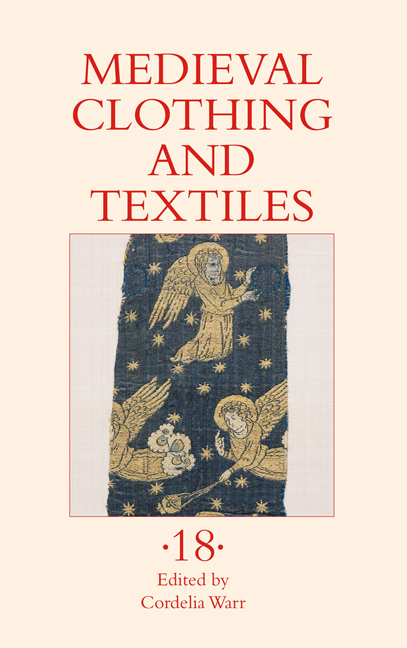Book contents
- Frontmatter
- Contents
- Illustrations
- Tables
- Contributors
- Preface
- 1 Linen Armour in the Frankish Countries: The Twelfth Century
- 2 Serial Production and Individualisation in Late Medieval Silk Weaving
- 3 The Trousseau of Isabella Bruce, Queen of Norway (The National Archives, Kew, DL 25/83)
- 4 Make and Create: The Craftswomen in the Salone Frescoes of the Palazzo della Ragione, Padua
- 5 Combs, Mirrors, and Other Female Beauty Bling in the Later Middle Ages
- 6 The Dividing Lines of Social Status in Sixteenth-Century Scottish Fashion
- Recent Books of Interest
- Author Index, Volumes 1–17
Preface
Published online by Cambridge University Press: 10 May 2024
- Frontmatter
- Contents
- Illustrations
- Tables
- Contributors
- Preface
- 1 Linen Armour in the Frankish Countries: The Twelfth Century
- 2 Serial Production and Individualisation in Late Medieval Silk Weaving
- 3 The Trousseau of Isabella Bruce, Queen of Norway (The National Archives, Kew, DL 25/83)
- 4 Make and Create: The Craftswomen in the Salone Frescoes of the Palazzo della Ragione, Padua
- 5 Combs, Mirrors, and Other Female Beauty Bling in the Later Middle Ages
- 6 The Dividing Lines of Social Status in Sixteenth-Century Scottish Fashion
- Recent Books of Interest
- Author Index, Volumes 1–17
Summary
This volume contains six essays arranged chronologically. As is often the case in volumes of Medieval Clothing and Textiles, a range of sources are discussed: literary and documentary material; clothing and material remains; frescoes, panel paintings, and images in manuscripts. Contents extend from the twelfth century to the sixteenth and geographically from southern Europe to Scotland and Norway.
The opening essay, by Sean Manning, investigates the use of quilted and linen armour. By the year 1160, warriors in Catholic Europe often wore quilted coats over, under, or instead of iron armour. Texts from the twelfth century onwards record this practice, but archaeological and iconographic evidence is very limited before the thirteenth century. In addition, texts provide information that paintings, sculptures, and surviving garments cannot, such as cost, the equipment of low-status soldiers, and what was hidden under visible outer layers. However, references to soldiers wearing quilted coats appear in a wide variety of texts in different languages with different vocabulary. This article, which is the first in a planned series, provides the most important references to these garments across Western Europe in both their original language and in translation. Looking at texts in Latin, the Romance languages, the Germanic languages, and Old Irish suggests that the different terms for quilted coats were more or less interchangeable in this period. By the late twelfth century, soldiers’ quilted coats were part of a cultural package with items like covertures (trappers for horses), cuiries (leather defenses for the chest), and iron hats. The article also raises the question of why the earliest evidence comes from the British Isles and northern France, when the technology may have been imported from the cotton-growing regions around the Eastern Mediterranean and the Black Sea.
Michael Peter, in the second essay of the volume, moves from linen to silk and from literary to material sources, looking at serial production in late medieval silks. Medieval silk weaving was characterised by the different interests of producers and consumers. The buyers’ needs for exclusivity and individual self-representation were contrasted on the side of the manufacturers by the mechanisms of the market and the rules of serial production, which aimed to economise and standardise the weaving processes as much as possible. Opportunities to modify patterns and motifs to fit individual preferences were extremely limited.
- Type
- Chapter
- Information
- Medieval Clothing and Textiles , pp. xiii - xviPublisher: Boydell & BrewerPrint publication year: 2024



